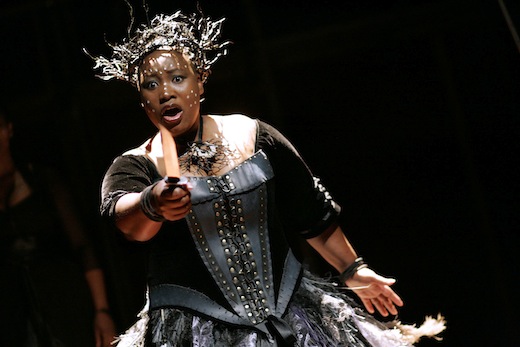
Guaranteed, you have never seen or heard Mozart anything like this! Warning: This may be the only way you’ll ever want to hear Mozart again!
The Isango Ensemble, a South African theater company based in Cape Town, draws its performers from the Black townships surrounding the city. They specialize in taking classics from the world canon and re-imagining them in the South African context. Besides Mozart’s The Magic Flute, they have tackled the operas Carmen and La bohème, as well as Shakespeare’s Venus and Adonis. Films have been made of some of their productions.
The de- and re-constructed Magic Flute (Impempe Yomlingo) has been seen worldwide, and is currently on a North American tour (details below). It won the Olivier Award in London, and a Globes de Cristal award for Best Opera Production at the Théâtre du Châtelet in Paris. See it if you can!
The Metropolitan Opera in New York City has seen declining ticket sales in recent years, for reasons not entirely understood. High ticket prices no doubt figure in, and perhaps unimaginative marketing. HD live broadcasts into movie theaters have apparently not stimulated sufficient desire to occupy an actual seat in the house. But maybe it’s the repertoire that needs jazzing up a bit.
Let us put one concept to rest right away: That the operatic score and text are sacrosanct and not to be tampered with. This has never been true, not for a single moment ever since the beginning of opera. Operas have been given wholly new time frames (Carmen during the Spanish Civil War or Les dialogues des Carmélites during the Nazi occupation of France come readily to mind, but there are many other examples). Orchestras have been enlarged, or reduced. Different composers have come along and orchestrated piano scores (Mussorgsky’s operas are a case in point). Scenes are added, re-ordered, and dropped. Sometimes work by other composers is interpolated, and some early operas were little more than pastiches of arias by many composers, a custom the Met revived for its recent baroque extravaganza The Enchanted Island. The language of performance often changes from the original. Baroque opera composers expected individual singers to provide their own ornamentations on their arias, and many of these, improvised from night to night, were never even written down. And let’s not even start on vocal quality: Some dramatic voices for music theater are very different from the type originally intended by the composer.
So there is no law against any of these practices. One can only hope that the producers keep faith overall with the original intentions of the creators. In this sense, the Isango version conforms totally with the populist vision Mozart had with Die Zauberflöte, written in the German vernacular (unlike the Italian he chose for most of his other operas), meant to appeal to popular audiences with a forever fascinating mix of high-flown idealism, heavily influenced by his Masonic beliefs, with low-brow comedy by almost clown-like characters.
Not a single stringed instrument is played or heard in Impempe Yomlingo. Mozart without a string section? Impossible! Yet soon enough the ear gets accustomed to the unfamiliar but authentic sound of a choir of marimbas (eight by my count), played masterfully by, so it seemed, just about every member of the two-dozen strong company at one time or another during the evening. Percussion also figures in, and one trumpet in free jazz riffs filling in for the magic flute solos. Otherwise, the frenetic all-acting, all-singing, all-dancing, all-musician cast joins in not only on Mozart’s choruses, but also supplies vocal sound à la Swingle Singers (South African style), both verbal and nonverbal, to fill out the composer’s harmonic intentions. They provide a constant Greek chorus-like commentary, sometimes just with a mood, not words, on the action. Graceful syncopations add a little tropical flava to Mozart’s tunes. I thought I heard a tango at one point. As far as I could tell, arias were sung in original keys. Pauline Malefane and Mandidi Dyantyus provided the music arrangement.
In other words, this Magic Flute takes the point of the beloved 1791 opera and owns it for a worldwide audience more than two centuries later, not to pervert it but to share its wisdom and its glories with today’s theatergoers. As adapter, director, writer and Isango co-founder Mark Dornford-May says, the original work “was created to be performed in a suburban theater for ‘ordinary’ people-not the aristocracy. It is a world-beating piece of music storytelling, and it has always belonged to every man” (everyone, I might have said).
Scenically the production is rich with costumes designed by Leigh Bishop, headdresses and hair, painted faces, backdrops, projections, and special effects. Everyone is barefoot. The Spirits (a trio of pre-adolescent boys in standard productions) come out in cute little outfits like the Supremes with feathered wings. Individual performers are not identified in the program for specific roles, so I’m sorry I can’t single them out. Clearly these singers have advanced vocal training, and many are quite good. But it’s truly the ensemble that counts.
If you are not familiar with the plot of the opera, you might want to bone up on it beforehand-it’s printed in the program but you may not have the time to read and absorb it then. Because truthfully the words are hard to understand, especially as they drift back and forth between South African-accented English and one (or more?) unspecified African indigenous language, and there are no supertitles. You don’t really need much more than familiarity with the plot. The full libretto is supplied for later perusal, and considerable amusement, a definite operatic collector’s item.
As opera lovers know, Magic Flute pivots on the contest between the saintly, if demanding figure of Sarastro, the revered leader, a basso profundo, and his erstwhile consort the Queen of the Night, a wrathful, vengeful, wronged lady portrayed by a sparkling coloratura soprano. With his noble bearing and soothing words, it would be impossible not to see Sarastro as an embodiment of Nelson Mandela in a previous life. Here is his reconciliation aria, sung just after three of his guards have been murdered:
Lights! Lights!
Each one of us has suffered
Each one of us has fought the fight
Each one of us is angry
Each one believes he’s right
But guided by each other’s hand
We travel to better land (2)
On this long walk we are going
We must walk without fear
For many tears have fallen
But we must keep going ahead
We cannot drown, we cannot burn
For then another takes their turn (2)
That is the lesson that we learn.
Sarastro presents the two young lovers Tamino and Pamina to his (originally Masonic) order, now looking much more like a Central Committee meeting of the African National Congress, seated on plastic crates and replete with raised fists and choral freedom songs. He explains his decision, once they have overcome their three tests, to pass power over to the pair-a male and a female, to be specific, upsetting the strictly patriarchal past. Speaking of Pamina, his daughter with the Queen of the Night, he summarizes:
“I saved her from her power-hungry mother. Her mother is an ambitious conniving and bitter imperialist. She will destroy everything we stand for: Honor, Virtue and Wisdom. We need new leaders who will protect our principles. Their power lies in their union. If they are worthy, they will pass these tests of love and faith. Comrades, are my decisions approved?”
“Yes, Viva Sarastro, Viva,” they reply.
I did not get all those words in performance. Nor did I get from the staging that Winnie Mandela was necessarily the reference to the Queen of the Night-that might be taking the metaphor all too literally. But yes, in a temple whose motto is “Nature” and “Reason,” evil is personified as the old exploitative ways of the world which we must collectively learn to stuff firmly into the ashcan of history. This is the message of the new South Africa, “inspiring new ways,” as their current tourist brochures put it. Isango is a worthy ambassador.
The tour is sponsored by South African Tourism, with special support from South African Airways.
For further information about the Isango Ensemble and to see promotional clips of the opera, go to http://www.cami.com/?webid=2347&flvrec=19944#player
The Magic Flute plays at the Broad Stage in Santa Monica through October 12. For more information contact: www.thebroadstage.com or call 310.434.3200.
The production moves on to the Center Stage Head Theater in Baltimore, October 17-19, the Cutler Majestic Theater in Boston, October 21-26, and the New Victory Theater in New York, October 29-November 9.
Photo: Photo: Queen of the Night Pauline Malefane (Keith Pattison)










